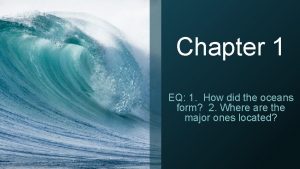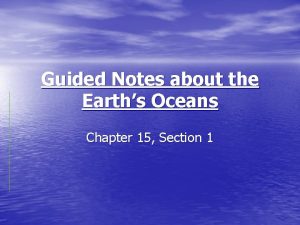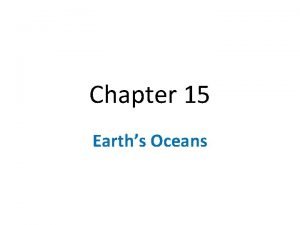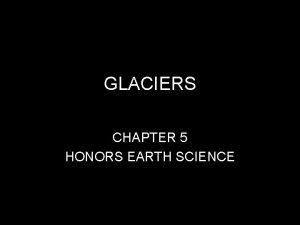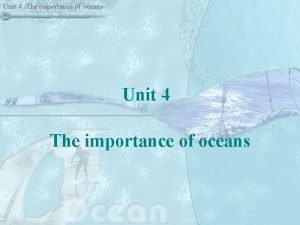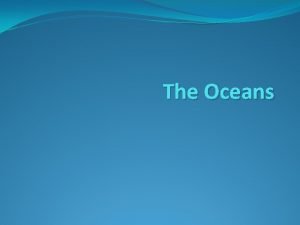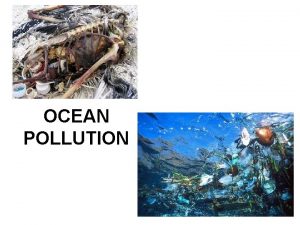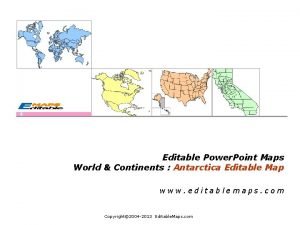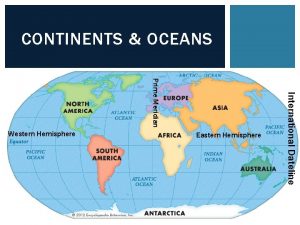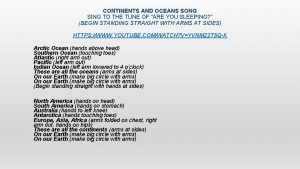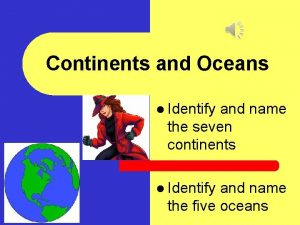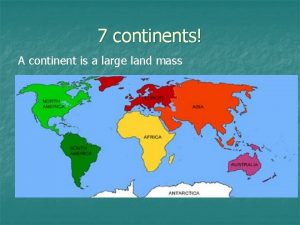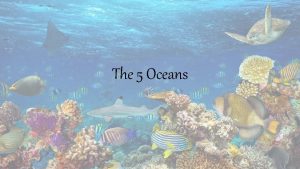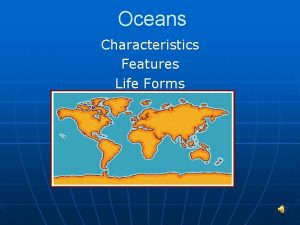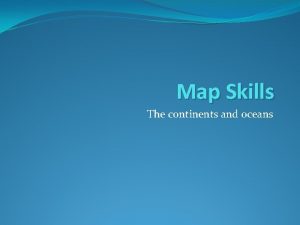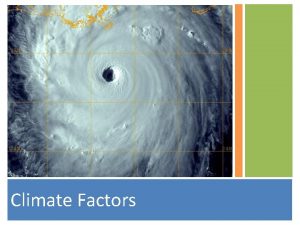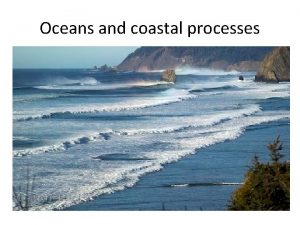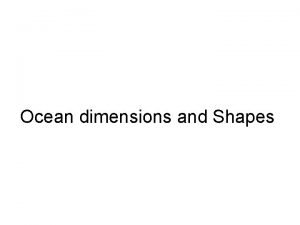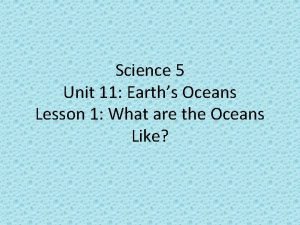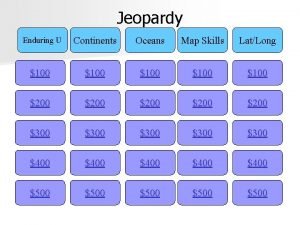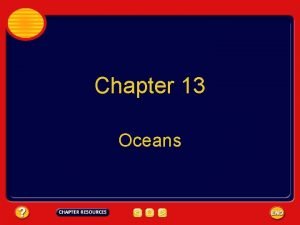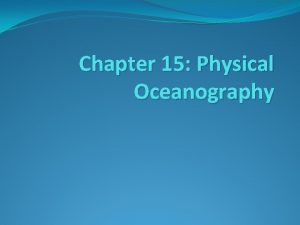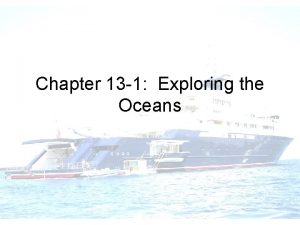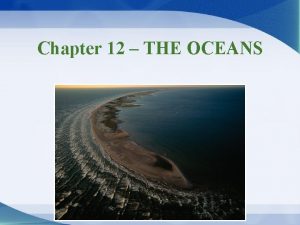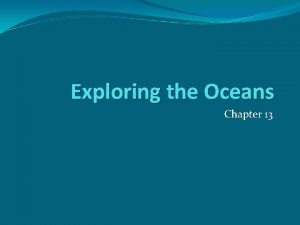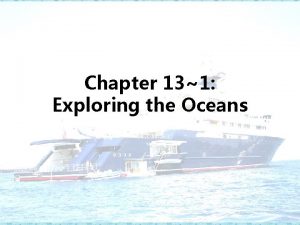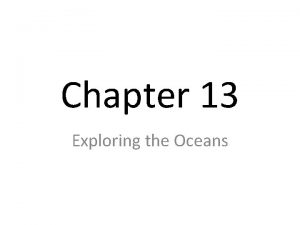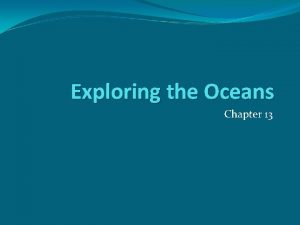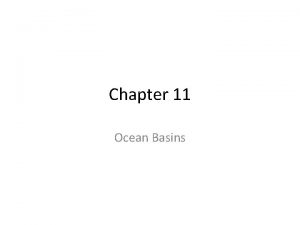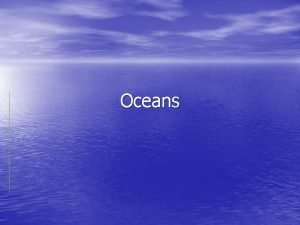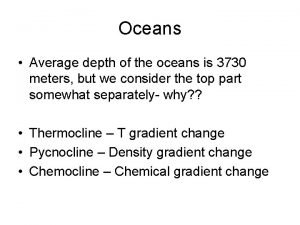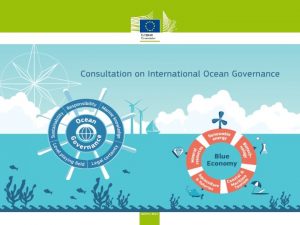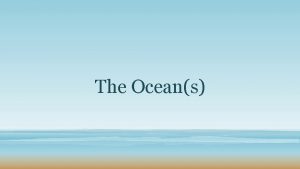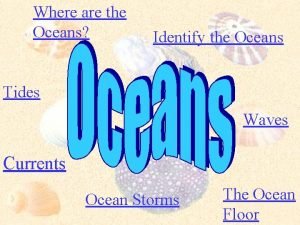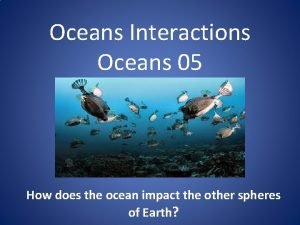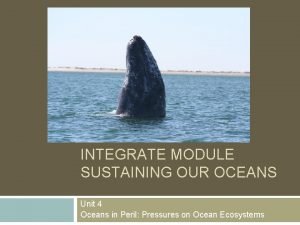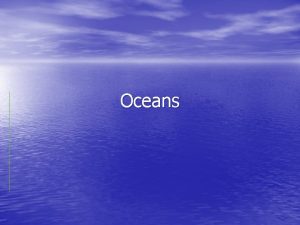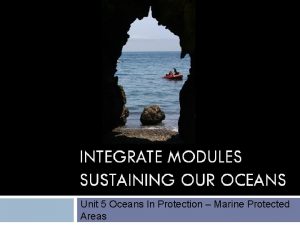Chapter 1 EQ 1 How did the oceans





























- Slides: 29

Chapter 1 EQ: 1. How did the oceans form? 2. Where are the major ones located?

Oceanography • Oceanography is the study of all aspects of the marine environment. • To do this, we need to use many different sciences. • Often times, the knowledge of multiple sciences is needed to see how each aspect works together.

Oceanography • • • Biology • Marine life, Adaptations, fisheries • Seawater composition, Pollutants, Density, temperature changes • Geology • Chemistry • • Waves, currents, pressure changes, light, sound Geography • Physics • Plate tectonics, sediments, coastlines World climates, wind belts, current systems Astronomy • Formation of earth, origins of oceans, tidal cycles and forces

Formation of Earth and the Solar System • Nebular hypothesis – all bodies in the solar system formed from nebula • Nebula = cloud of gases and space dust • Mainly hydrogen and helium

Nebular Hypothesis • Gravity concentrates material at center of cloud (Sun) • Protoplanets form from smaller concentrations of matter (eddies)

Protoearth: Our early earth • Larger than Earth today • Homogeneous composition • Bombarded by meteorites • Moon formed from collision with large asteroid

Protoearth • Radioactive heat Spontaneous breaking apart of atoms • Releases heat energy • Means protoearth was HOT HOT! • • Gravity pulls matter towards the center of the earth, contracting the matter • Earth is heated from the extra pressure from contraction • This makes Protoearth partially melt (lots of lava) • Density stratification (layered Earth)

Density Stratification • High density = heavy for its size • Early Earth experienced gravitational separation. • High density materials (Iron and Nickel) settled in core. • Less dense materials formed concentric spheres around core. • Least dense gases left the earth to begin to form the atmosphere

Earth’s Internal Structure Layers defined by • Chemical composition • Physical properties

Layers by Chemical Composition • Crust • Low-density, mainly silicate minerals • Mantle • Mainly iron (Fe) and magnesium (Mg) silicate minerals • Core • High-density, mainly iron (Fe) and nickel (Ni)

Origin of Earth’s Atmosphere • Outgassing • Less – occurred during density stratification dense gases drift up into the atmosphere Water vapor • Carbon dioxide • Hydrogen • Other gases • • Earth’s • early atmosphere different from today Lacks oxygen, would be toxic to us now

Origin of Earth’s Oceans • Outgassed water vapor fell as rain. • The first permanent oceans formed 4 billion years ago. • Salinity developed from dissolved rock elements. • Early acidic rain dissolved more crustal minerals than today.

Development of Earth’s Oceans

DO NOW #1 • We have been and will continue to look at the formation of earth and the oceans, information about each ocean, and where the major oceans and seas are located. • From the first day, what areas of science are we using today? (biology, chemistry, physics, geology, geography, astronomy)

Life’s Possible Ocean Origins • Earth’s earliest known life forms are 3. 5 -billion-year-old bacteria fossilized in ocean rocks. • These Earth. • There are the building blocks for life on early is no direct evidence of early Earth’s environment.

The Beginning…. • The world ocean is the most prominent feature on Earth. • Oceans cover 70. 8% of Earth’s surface. • The origin and development of life on Earth is connected to the ocean. • The oceans have a long history on Earth.

Earth’s Oceans • Earth has one ocean. • It is divided into four principle oceans, and one other. • • • Pacific Ocean Atlantic Ocean Indian Ocean Arctic Ocean Southern, or Antarctic Ocean

Ocean Info a) oceans cover 70. 8% of the earth b) of the major oceans, the Pacific is the biggest c) the Pacific, Atlantic, and Indian are around the same depth. The Arctic is much shallower. d) the oceans are deeper than the land is tall.

Comparing Oceans to Continents • Average ocean depth is 3729 meters (12, 234 feet) • Average continental elevation is 840 meters (2756 feet) • Deepest ocean trench is the Mariana Trench at 11, 022 meters (36, 161 feet) • Highest continental mountain is Mt. Everest at 8850 meters (29, 935 feet)

Earth’s Oceans • Pacific Ocean • World’s largest ocean • Accounts for more than half of Earth’s ocean space World’s deepest ocean Earth’s largest geographic feature • Named in 1520 by Ferdinand Magellan for his peaceful journey across it. • •

Earth’s Oceans • Atlantic Ocean • Half the size of the Pacific Ocean • Shallower than the Pacific Ocean • Named after Atlas, the Greek Titan • Indian Ocean • Smaller than the Atlantic Ocean • Similar depth as the Atlantic Ocean • Primarily in the Southern Hemisphere

Earth’s Oceans • Arctic Ocean Seven percent the size of the Pacific Ocean • Shallowest world ocean • Permanent layer of sea ice a few meters thick •

Earth’s Oceans • Southern Ocean or Antarctic Ocean Circumnavigates Antarctica • Is really the parts of the Pacific, Atlantic, and Indian Oceans that lie south of 50° S latitude •

The Seven Seas • Smaller and shallower than oceans • Salt water • Usually enclosed by land • • Sargasso Sea defined by surrounding ocean currents Directly connected to the ocean • Before the 15 th Century, Europeans considered the seven seas to be the following: 1. 2. 3. 4. 5. 6. 7. Red Sea Mediterranean Sea Persian Gulf Black Sea Adriatic Sea Caspian Sea Indian Ocean

Seas • Now that the oceans have been explored further (and we know we are not going to fall off the edge of the earth) there are many more than 7 seas. • Here are some of the top ones:

Seas • 1. Mediterranean • 2. Red Sea • 3. Adriatic Sea • 4. Black Sea • 5. Caspian Sea • 6. Persian Gulf

Seas • 7. Arabian Sea • 8. Bay of Bengal • 9. Hudson Bay • 10. Labrador Sea • 11. Gulf of Mexico • 12. Caribbean Sea

Seas • 13. Bering Sea • 14. Sea of Okhotsk • 15. Sea of Japan • 16. Coral Sea • 17. Scotia Sea • 18. Weddell Sea

Closure: • 1. Why is Oceanography called an interdisciplinary science? • 2. How did the earth form? • 3. How did the oceans form?
 How did the oceans form
How did the oceans form Chapter 15 earth's oceans study guide answer key
Chapter 15 earth's oceans study guide answer key Oceans
Oceans Chapter 5 glaciers oceans and landscapes
Chapter 5 glaciers oceans and landscapes Importance of marine life
Importance of marine life Importance of oceans
Importance of oceans The five major oceans
The five major oceans Are all the oceans connected
Are all the oceans connected Ocean apart day after day
Ocean apart day after day Pacific garbage patch
Pacific garbage patch Oceans 7/11
Oceans 7/11 Antarctica outline map
Antarctica outline map Oceans in the eastern hemisphere
Oceans in the eastern hemisphere Map of continents and oceans for kids
Map of continents and oceans for kids Continents and oceans song
Continents and oceans song All continents and oceans
All continents and oceans What are the 7 continents and 5 oceans
What are the 7 continents and 5 oceans The prime meridian runs through which 3 continents
The prime meridian runs through which 3 continents What's the 5 oceans
What's the 5 oceans Characteristics of oceans
Characteristics of oceans Continents and oceans map
Continents and oceans map Water oceans
Water oceans Oceans cover approximately
Oceans cover approximately Shape of oceans
Shape of oceans Oceans
Oceans 5 oceans in the world
5 oceans in the world Ocean atmosphere and climate
Ocean atmosphere and climate Continents and oceans jeopardy
Continents and oceans jeopardy Continents and oceans jeopardy
Continents and oceans jeopardy France 5 themes of geography
France 5 themes of geography
